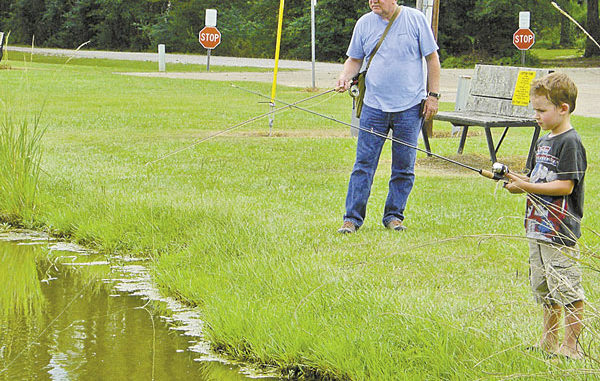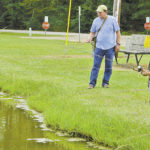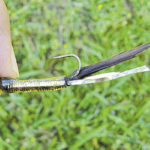
Neighborhood ponds are great option for bream fishing.
In my neighborhood, “A Ditch Runs Through It.” It connects two neighborhood lakes, so it maintains a constant water level.
As early as late February, I’m fishing the ditch, and the two lakes. And every other small water I can cast my fly line on.
Some friends think this is to occupy my spare time until the weather on the coast settles, or until the prime freshwater areas heat up. Apparently they don’t know me well enough.
I live for ponds!
Regardless of where you live in our state, there’s a public pond or small water near you. I’ve fished Lincoln Parish pond in Ruston, Cane River Lake in Natchitoches (downtown section is pondlike), Oil City Park in Jennings, Zemurray Pond in Hammond, the ponds at Sherburne Wildlife Management, the New Orleans City Park ponds, all of the dozen BREC ponds in Baton Rouge, and many more.
And most of us know one or several folks who have private ponds. Often just asking permission gets an invite. It doesn’t hurt to offer a jar of my mom’s famous fig preserves in return.
Why are ponds so flyfishing friendly?
They’re typically clear, and as Cormier’s Second Law states, clear water favors the fly angler. The food supply to pond predators consists of aquatic bugs (imitated by dries, nymphs), terrestial bugs (imitated by popping bugs, foam spiders), grass shrimp (imitated by scuds), crawfish (imitated by woolybuggers) and minnows (imitated by fluff butts).
Further, ponds usually maintain more stable water temperatures year-round. It’s not unusual for bream action to rev up as early as mid-February, and continue strong through April.
A properly managed pond can produce both good numbers and good sizes of bass and bream. Two reasons why a pond isn’t reaching its potential: too much harvest of bigger bass, and poor water chemistry.
I always advise pond owners to practice catch-and-release on bass, keeping a big one every so often, and relying mostly on the bream for table fare.
As for water chemistry, water hardness is the limiting factor in aquatic biomass production. Use a pool kit with a calcium hardness test to determine the hardness of your pond. If it’s below 40 ppm, you’ll find that the application of 120 pounds of garden lime per surface acre during winter, followed by a spring application of 8-8-8 fertilizer, can result in more, bigger fish — provided you maintain a controlled harvest.
Ponds are where new flies are put to the test, and stars are born.
A few years back, at the Acadiana Fly Rodders annual conclave in late February, I won a posterboard of flies in a raffle. It contained over a hundred flies tied by members of the club.
When I got it home, I started picking through the collection, seperating them into boxes for salt water, bream, bass and coldwater trout. Of greatest interest were the bream flies. The gobbules — those big, hard-charging bluegills and redears — were turning on at the neighborhood lake, as well as most of the other ponds in the area.
Some of the flies I knew could catch gobbules, including the Black Boudreaux created by AFR member Ray Boudreaux.
Good luck finding a Black Boudreaux in a fly shop. Or for that matter, many of the proven killer bream flies we use here in Louisiana like the Jitterbee, Cap Spider, Cajun Tickler, Fluff Butt, Bead Cuzz, to name a few.
This shouldn’t come as a surprise. Of the estimated tens of thousands of fly patterns, only a small fraction are sold commercially. It’s the reason many of us take up tying.
I was hoping to find the next great bream-catching fly on this posterboard. Over the next month, I tested out the “unknown patterns” on a wide variety of waters. Some did well, others didn’t. But there wasn’t one that stood out above the rest.
At least, not one I knew of.
Turns out there was one fly that had fallen from the posterboard the night I brought it home. When I discovered it, my wife claims I set a new record in the 400-meter dash. That’s about how far it was from my back door to the edge of the neighborhood pond.
Four of the five voices in my head told me this fly was going to be special. The instant I cast it out and it hit the water, the fish were over it like crawfish etouffee over rice!
Since then, I’ve done very well with this fly for bass, bream, crappie and pickerel. I’ve even tied a saltwater version for redfish, and it’s done well too.
So what is the name of this fly?
It’s the Amnesia Fly. It doesn’t recall what it’s real name is, or who tied it. We certainly tried our best, sending emails and posting to various forums. But no response.
Here’s the recipe, in case I get amnesia myself and forget. Hook — Mustad 9672 sizes 6 or 8 (larger for bass). Tail — Marabou. Body — metallic braid wrapped around the shank, with one strand of wide flashabou on each side, then the body is overwrapped with monofilament or small diameter v-ribbing. Head — built up with thread then epoxied over.
The best colors have been olive, purple and black. But experiment, and see what works.
If you have a killer fly that you’d like to share, please send it to catch@laflyfish.com.




